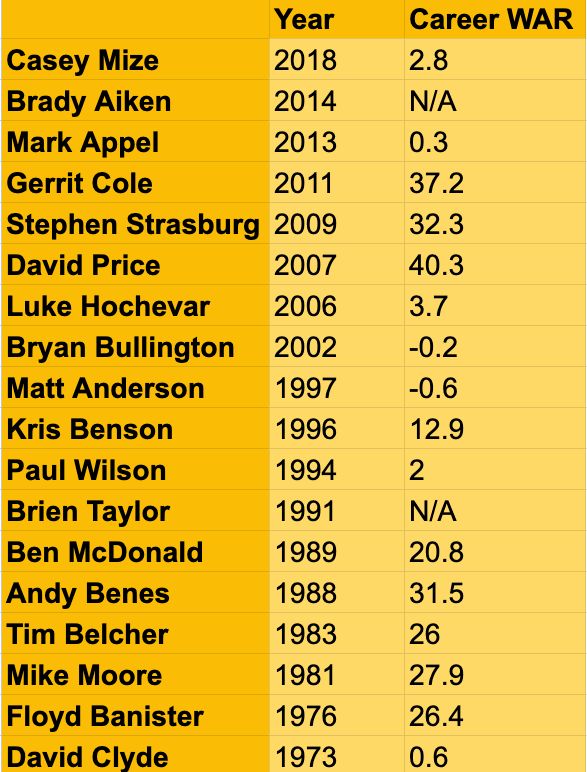SEATTLE -- So the Pirates ended up taking an LSU player first overall in the draft after all.
Hard to argue against that choice, especially when the word "generational" keeps popping up when television analysts keep talking about him.
Faced with one of the most pivotal decisions in his tenure as Pirates general manager, Ben Cherington and the draft team went with the highest graded pitching prospect in years. That would be Paul Skenes, taking the flame-throwing right-hander who has a chance to be on of the best pitchers on the Pirates sooner rather than later.
"We wanted the player who we thought would help the Pirates win the most games over time," Cherington said. "That’s what we always go back to."
Is there risk to taking a pitcher first overall? Sure. An injury could sideline them longer than a position player and it could potentially affect the stuff. And as far the pitchers who went first overall in the draft, the results are pretty mixed:

Of the 18 pitchers ever taken 1.1, six finished with 2 career WAR or less, including 2002 Pirate pick Bryan Bullington. Actually, the previous three times the Pirates had taken a pitcher has resulted in one bust (Bullington), one pitcher who had a decent but not outstanding career (Kris Benson) and one who has competed for Cy Youngs and has an outside chance at the Hall of Fame (Gerrit Cole). Historically, that's balanced, though the goals should certainly be loftier than that.
There's risk and a less than stellar track record, but a high draft pick is one of the few ways the Pirates can realistically acquire an ace. They won't sign one in free agency and teams are hesitant to trade blue chip pitching prospects. That leaves the draft, international free agency and development, the last two of which usually can only go so far. The Pirates went after who they felt was the best player in the draft, but it happens to be at a position where if you don't acquire impact talent early, it's difficult to acquire it at all.
So what make Skenes the best player available in this draft? Well, it starts with the stuff. After all, you don't get to 209 strikeouts over 122 2/3 innings without some serious weapons in your arsenal.
Skenes sits at a ridiculous 98 mph on his fastball, something only five other starters in this league can claim (Carlos Hernández, Bobby Miller, Jacob deGrom, Hunter Greene and Mason Miller). He's also ramped up his velocity to 102 mph on the mound, something that only Greene and Miller have done as starting pitchers in this league this season.
deGrom was one of the pitchers Skenes looks up to (alongside Spencer Strider of the Braves and Yu Darvish of the Padres to name a few), and there are definite similarities in their deliveries, especially in that follow through:
Paul Skenes vs. a slightly sped-up Jacob deGrom pic.twitter.com/MqnVZ7iRfA
— David Adler (@_dadler) June 12, 2023
"I know I probably don’t look exactly like any of those guys, but that’s what I feel as I move down the mound," Skenes said.
Velocity isn't always a one-to-one translation from the college game -- there's a big difference between pitching once a week and every five days -- but there's potential here for this to be an elite fastball. And since it spins, it gives the illusion of rise:
What an at-bat vs. Paul Skenes looks like:
— Rob Friedman (@PitchingNinja) June 23, 2023
100mph Fastball
88mph Slider
88mph Slider pic.twitter.com/6s13uyiCP3
Second is that slider, which you can see gets plenty of horizontal movement.
That's been the big separator between Skenes at his time with Air Force Academy and his year with LSU. He was only fastball-changeup in high school because of his coach's rules, so the breaking ball was a bit behind and had a traditional shape. This past summer and fall he started to develop it into a sweeper, and it certainly gets plenty of movement. Quickly he went from getting about 2300 RPM of spin and 2.5 inches of glove-side run on his breaking ball to 2,600 RPM and 12 inches.
"As my velocity increased, my hand sped up and I got a better feel for that breaking ball," Skenes explained.
I went through Baseball Savant's pitch data to look for pitchers who get roughly that much velocity, movement and spin, and the best three I could find are Graham Ashcraft, Gerrit Cole and Shohei Ohtani. That's pretty good company.
Throwing in side sessions this year, Skenes tried to dust off that gyro slider, but since his body had changed and his delivery had sped up, it turned more into a curveball shape. That curve is another option for a third pitch if the changeup doesn't come along.
But even if that third pitch doesn't come along, Skenes has the power stuff that could play even with just the two pitches. It's a closer pitch mix but with a starter's durability. It's why people want to see that stuff in the majors as soon as possible.
It's not going to be that quick, but the fact that it's being considered right out of college should tell you everything you need to know.
"In a vacuum, people are telling me my stuff plays in the big leagues," Skenes said. "I also know that I’ve watched this game for so long, and it’s always felt so distant in a sense just because I’ve been a fan and sitting in the stands and watching all those guys compete... I think I’m close. I don’t know exactly how close, but I’m going to do everything in my power to get there as soon as possible."

